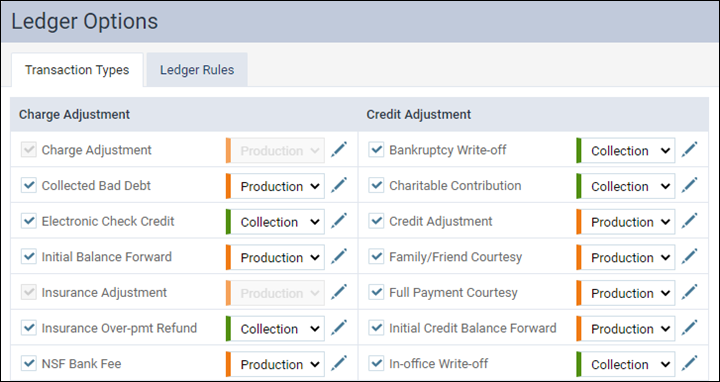September 22, 2020
To truly understand the revenue cycle, you must first understand your adjustments. If you are wondering “What is the purpose of an adjustment?” or “How do my adjustments affect my business?” you need to look at setting up Dentrix Ascend to track your adjustments correctly. Understanding adjustments helps make it clear what you give away; not understanding them may mean you’re paying providers for income you can’t collect.
Adjustments affect a patient’s ledger in one of two ways: charge adjustments increase the patient’s balance, but credit adjustments reduce the patient’s balance. For reporting purposes—to help everyone know why money was given or taken away—it can be useful to assign descriptions to adjustments. Dentrix Ascend comes prepopulated with common adjustment descriptions in both the charge and credit adjustment categories. You will find these on the Ledger Options page (from the Settings menu, click Ledger Options).
For example:

Within each adjustment category, several titles help you identify those adjustments (Collected Bad Debt, Full Payment Courtesy, and so on).
Although adjustments fall into those two categories, charges and credits, there is an additional dimension: how these adjustments affect your reporting. Let’s review production and collection adjustments that are taking place in our practices daily.
Collection Adjustments
Collection adjustments include refunds to patients, refunds to insurance and credit cards, returned check fees, or incorrectly posted payments. We consider these adjustments as collection adjustments because they affect the money already placed in your bank account. To illustrate, say your patient pays $10.00 on their account. Later the insurance payment comes in, and it is more than expected. Now, you refund $10.00 to the patient. Since that money was in your bank account, after refunding it, your bank account balance decreased by $10.00. Collection adjustments are important for reports because they reflect money that will be coming out of or not going into your bank account.
Production Adjustments
Production adjustments are more common than collection adjustments. You see them with descriptions like Senior Courtesy, Professional Courtesy, Staff Courtesy, and Credit Adjustment. Adjusting production means you make less money for your services. For example, say your fee for a procedure is $100.00. You offer a pay-today discount of 10%, and collect $90.00 from the patient. That’s great, except that you made $90 instead of the $100 you produced. Production adjustments are important to reports because they also reflect money that will not be going into your bank account.
Note that, if you are giving your patient a discount on a procedure, always charge out the full amount of the procedure, and reduce the amount by adding an adjustment. The walkout statement will show the patient they received a discount, and you will see just how much you are writing off.
How Adjustments Affect Accounts Receivable (A/R) Reports
Let’s look at how this will affect your accounts receivable (A/R) report. The Provider A/R Totals Report will show your net production and collection, meaning the total production/total collection after taking your adjustments into account. This is the amount that you will be able to collect on. Industry standards indicate that an acceptable “net collections to net production” percent is 98% or higher.

The Provider A/R Totals Report has two sections: Production and Collection. Because there are two types of adjustments, charges and credits, and either type can be assigned to production or collections, according to your ledger options both sections contain columns for charge adjustments and credit adjustments.
In the simplified example above, there is a $100 adjustment in the Production column under Credit Adj (this happens to be a Family/Friend Courtesy), and there is a $150 charge adjustment in the Collection column under Charge Adj (a patient refund in this case). When you set up your adjustments, pay close attention to what category you are assigning them to. If you had assigned the $100 adjustment as a collection adjustment instead of a production adjustment, your ending collection total would have been incorrect. This really plays a role if you are paying providers from total production or collection amounts.
Recommendation
Now that you better understand adjustments and how to label them as production or collection, I encourage everyone to review how yours are set up. Take a screenshot of how they are now and run the Provider A/R Totals Report; if needed, update your settings, and re-run the report. You will see how important it is to set up your adjustments correctly.

Ronda Borgman, Certified Dentrix Ascend Trainer
Ronda is dental practice team leader, business coach, and speaker with over 30 years’ experience. As a certified Dentrix trainer she was named Trainer of the Year and earned the Dentrix Ascend Spirit award. She has developed and implemented successful systems that improve workflow and the bottom line for Dentrix Ascend practices across the US.
